69. Pi /√3: A Geometric Way of Encapsulating Time Cycles at Giza?
- M Campbell
- Feb 17, 2024
- 13 min read
Updated: Aug 11, 2024

Geometry once played a practical role in old-fashioned astronomy, but did it also play a symbolic role, in relating the world of humans to the divine, or even a mathematical role, in relating key time cycles to each other?
The main solar and lunar time cycles are the solar, or tropical year, of 365.242199 days, the lunar year, of 354.36708 days, made up of 12 lunations of 29.53059 days, and the draconic year, of 346.62 days. At Giza, ratios between these, and other significant lunar and solar numbers, crop up as ratios between various dimensions of the site, often in connection with pi (π) and √3. Does the architecture encapsulate a system in which astronomical cycles interact as numbers, which are expressed in inches? How can we interpret the presence of pi and √3?
Geometry and astronomy
The signficance of these two irrationals, √3 and pi, could be due to the fact that the main solar and lunar cycles can be grouped into an equation, which is approximately equal to π /√3. It's possible that this equation is at the centre of the system which the pyramid complex represents, with the cycles measured out in days, represented as inches. It does form a remarkable coincidence.
365,242199 x 346,62 x 3/ (354,36708 x 29,53059 x 20) = 1,81468
π /√3 = 1,8138
It can also be written as 365.242199 x 346.62 x 3 / (354.36708 x 29.53059 x 10) ≈ 2 π /√3
or 365.242199 x 346.62 / 354.36708 ≈ 29.53059 x 20 π /(√3 x 3)
And indeed the length of the Great Giza Rectangle, as just over 100 x 29.53059 x 20 π /(√3 x 3) = 35 708.3769 inches (Flinders Petrie's measure is 35 713.2 inches), seems to suggest this could be an equation that is linked to the Giza design.
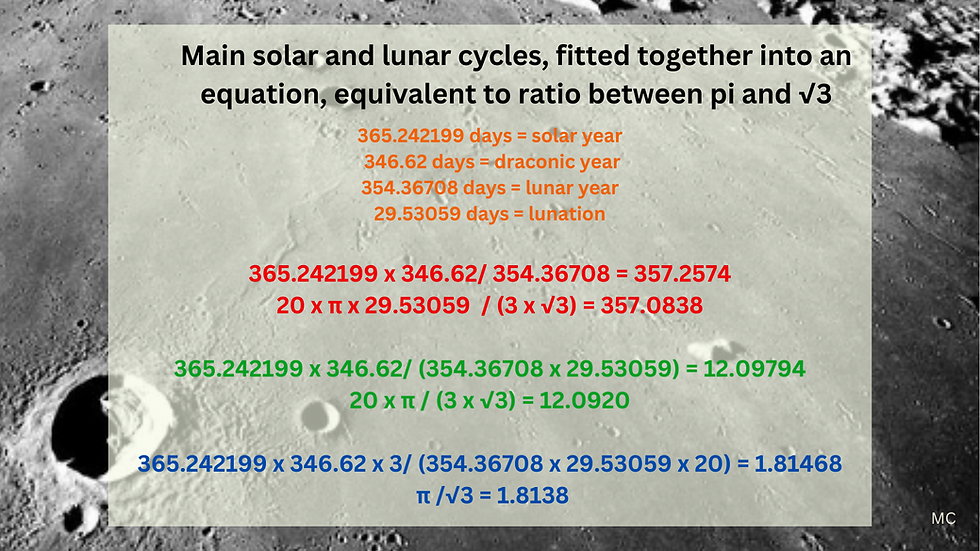
The fraction π /√3 can also link the sothic year to the lunar and draconic year, and a lunation, in particular when linked to the fraction 20π x 29.53059 /(3 x √3), as the graph below shows.

The important Metonic cycle, whereby the solar and lunar cycles are reconciled after 19 years, or 235 lunations, can be included in an equation that includes pi (but not √3) and the sidereal month of 27.32166 days, approximately. 365.242199² x 19 / (29.53059 x pi x 1 000) = 27.3208.

Even the average number of lunations per solar year can be expressed with π /√3, as 300 x π /(√3 x 44) = 12.3668. By comparison 365.242199 / 29.53059 = 12.3683.

These equations are derived from looking closely at Flinders Petrie's measures of the Giza site, and the ratios between various elements, heights, sides and distances. The most obvious example of a π /√3 ratio at Giza is the ratio between the side and the height of the Great Pyramid, as the height can be understood as 10 000 / √3 inches, and the side as 10 000 x π / (2 x √3) inches.
Some examples of ratios including π /√3 between dimensions at Giza are included in the diagrams below.
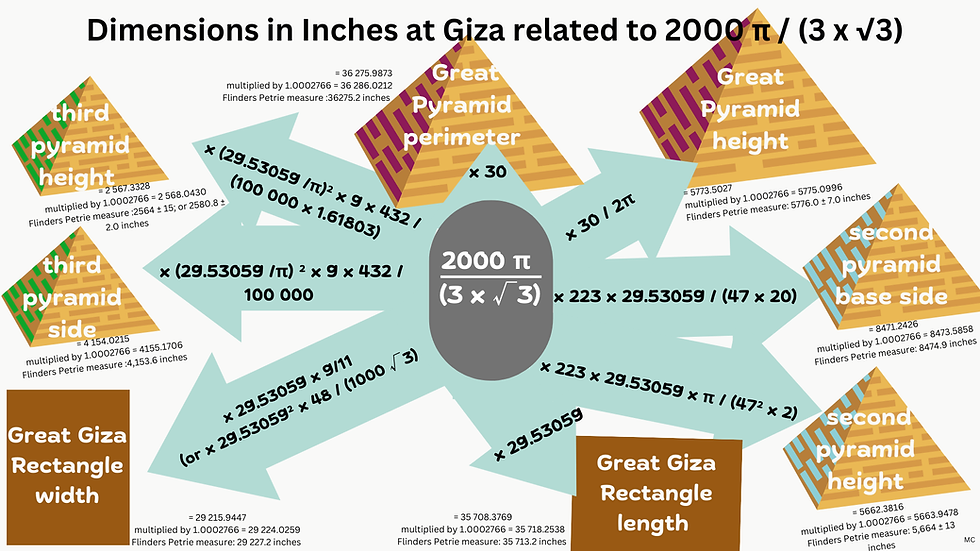
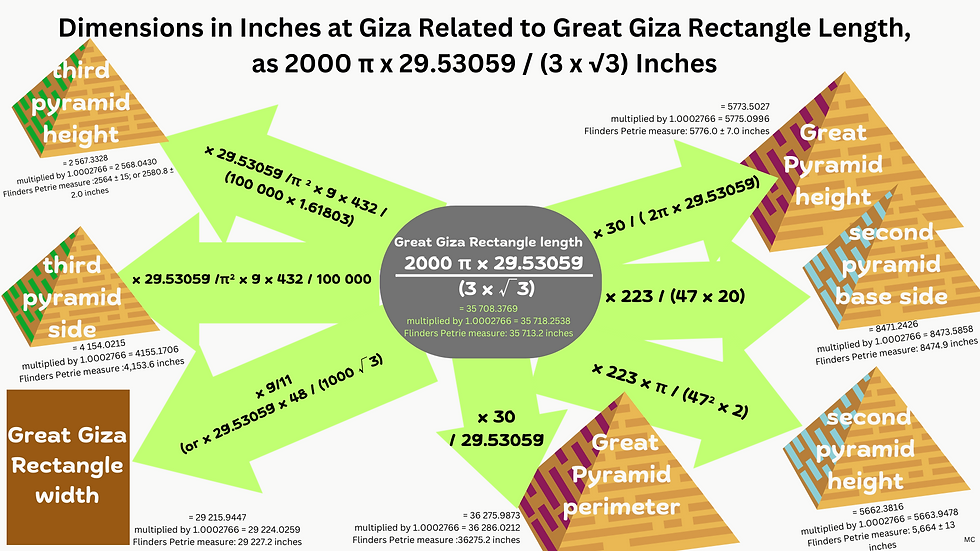
There are other ways of interpreting the relations between the various dimensions, but with 2000 π x 29.53059 / (3 x √3) as a common factor, it is easy to see a pattern forming. The fraction π / √3 can be substituted by 365,242199 x 346,62 x 3/ (354,36708 x 29,53059 x 20), to a good degree of accuracy.
The two diagrams below suggest that a simple geometric construction based on a length of 29.53059 inches can account for the width and length of the Great Giza Rectangle design, and for the ratios between other dimensions at Giza, by extension.
The geometric and astronomical values usually come up slightly too short compared to Flinders Petrie's values, suggesting perhaps, if this interpretation is valid, that the inch used today is very slightly bigger than the inch potentially used at Giza in ancient times, or that the astronomical time periods were computed slightly differently, or both. To try to determine by how much, two coefficients have been used here, to multiply the astronomical and geometric values by. One is a coefficient of 1.0001415, which is ((29 227.2 / 29 222.8685) + (35713.2 / 35708.3769)) / 2. The other coefficient also used is 1.0002766, both of which seem to work well to match the measures on the ground as determined by Flinders Petrie to the values derived from time cycles as day inches.
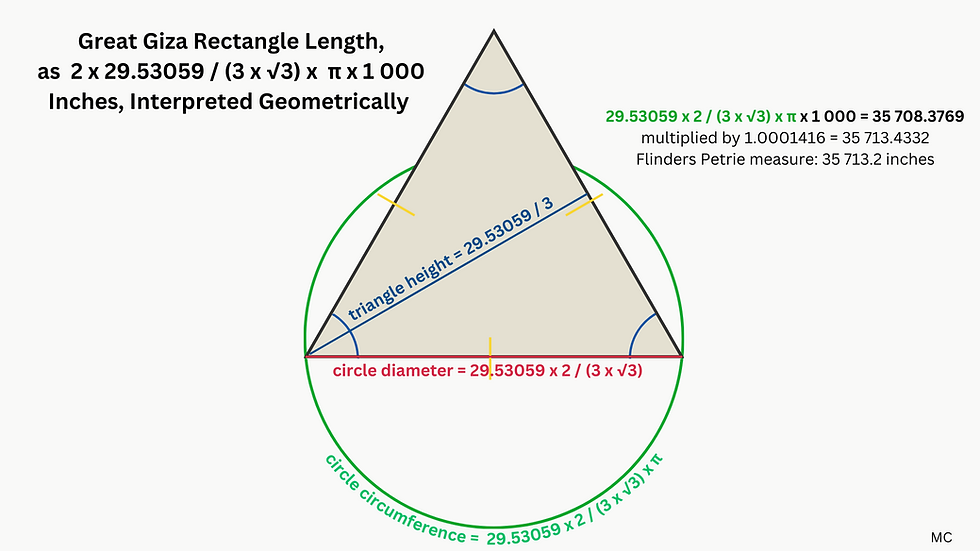
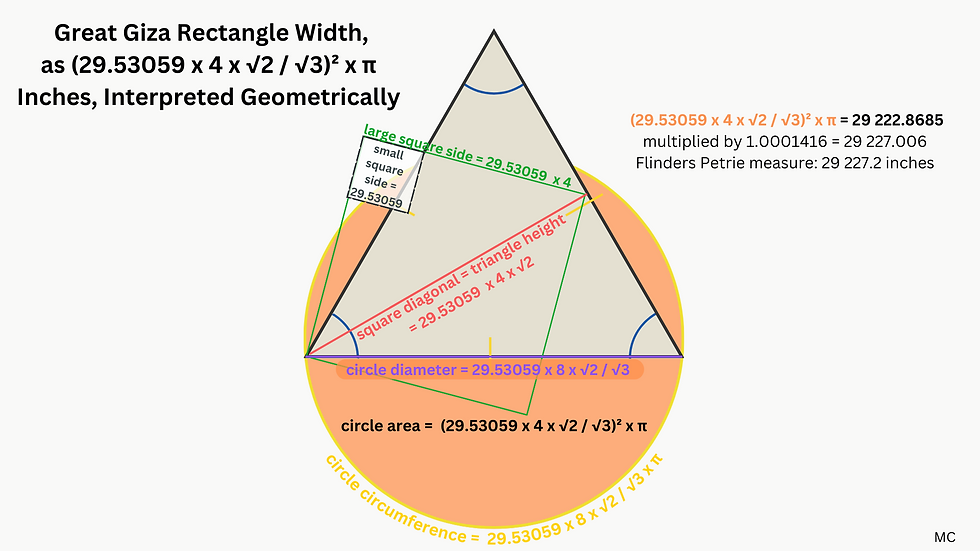
The most basic element of these ratios is π /√3, which geometrically illustrates the way in which the main time cycles combine as a fraction.

We can also think of the relationship between the solar, lunar and draconic years geometrically as 29.53059 x 20π /(3 x √3), as the graph below shows.

Indeed, the Great Pyramid has a base perimeter compatible with 20 000 π /√3 = 36 725.9873 inches, suggesting an initial circle with a diameter of 10 000 inches. And the second pyramid shows a connection to the π /√3 ratio together with the Metonic and Saros periods, or 235 and 223 months respectively, as it can be interepreted in inches as: π / √3 x 29.53059 x 1000 / 6 x 223 / 235 = 8471,2426.
The third pyramid side is 18 / √3 x 354.36708² / (π x100 ) = 4,154.0215, or 365.241199 x 18.02 x 354.32708² / (π x √3 x 100 x 365.242199)
Another way of expressing this, is by replacing π /√3 with 365,242199 x 346,62 x 3/ (354,36708 x 29,53059 x 20). So the Great Pyramid perimeter is then 3 000 x 365,242199 x 346,62 / (354,36708 x 29,53059) inches, and the second pyramid side is then 100 / 4 x 223 / 235 x 365,242199 x 346,62 / 354,36708 inches. (And we can then multiply these values by a ratio of around 1.0002766, which works generally well at Giza to bring the modern astronomical values up to the actual measures in inches found there by Flinders Petrie)
The Great Giza rectangle, encompassing the outer corners of the Great and third pyramids, has a width of 2/3 x π / (29.53059 x 4)² inches and a length of 2 π / (√3 x 3) x 29.53059 x 1 000 inches, and if multiplied by 30 / 29.53059, gives the perimeter of the Great Pyramid, which is almost equivalent to multiplying the length by 254 / 1000 to obtain a side of the Great Pyramid.
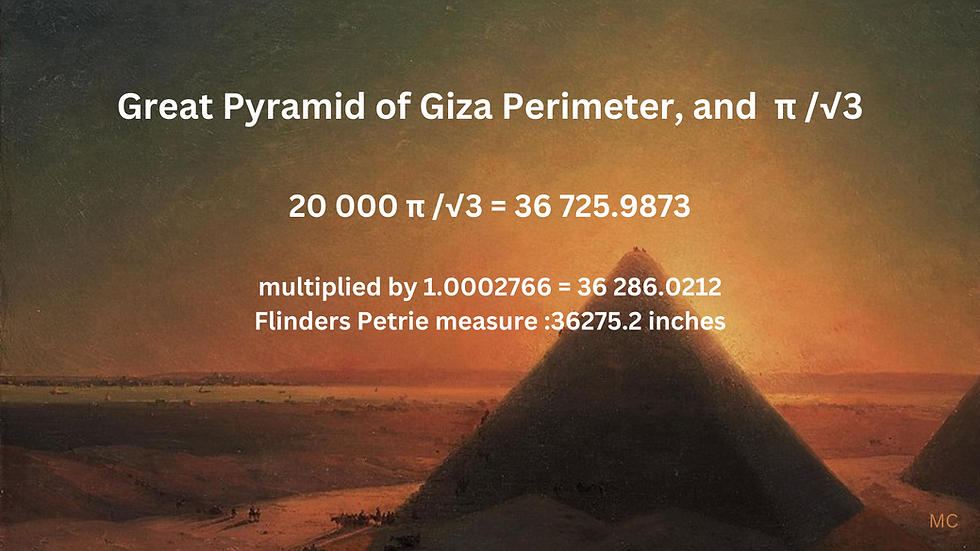
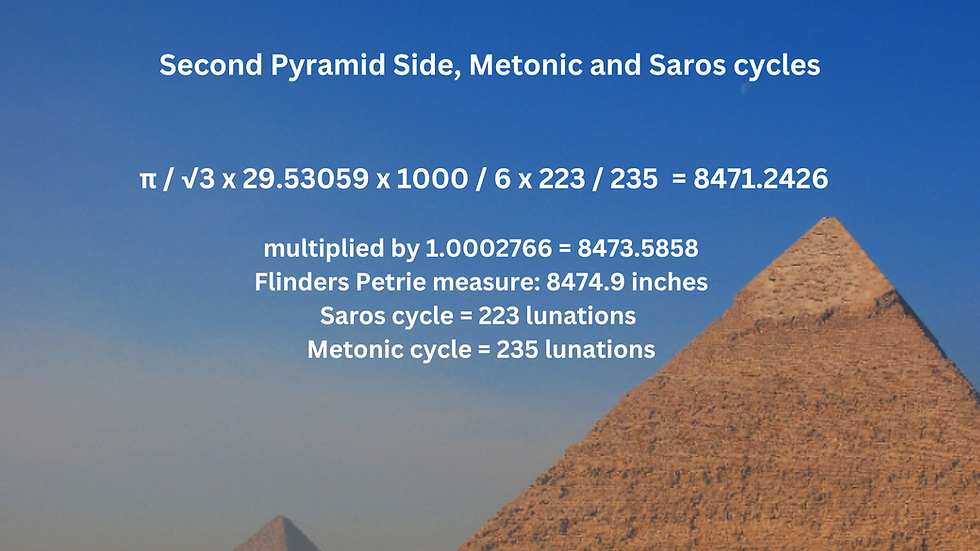
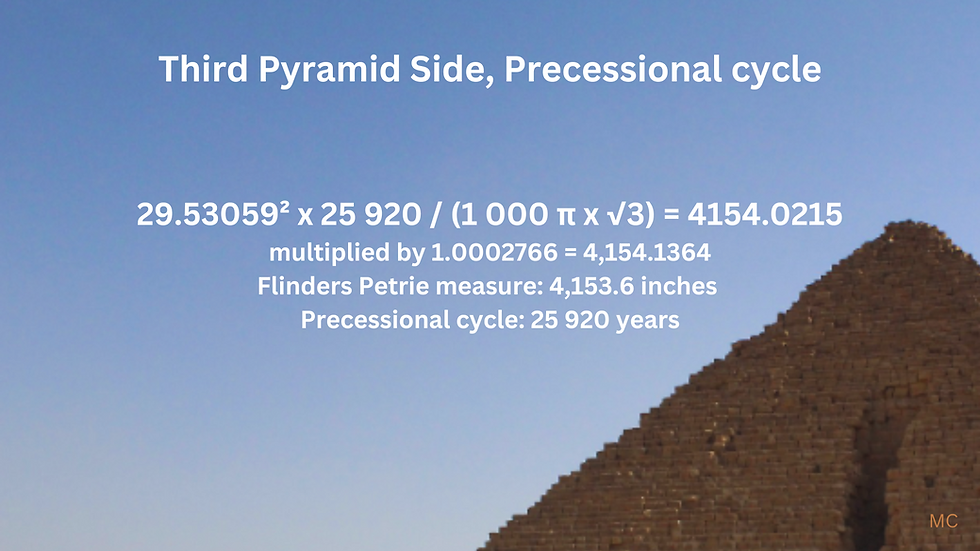

Units of measure connected to π / √3
The megalithic inch itself can be understood as connected to the square root of 3, as David Kenworthy has observed: √2 / √3 inches, 40 of which make up a megalithic yard. In fact, it can also be linked to the equation 2 π / √3 x 9 = 32.6484. The length of the Great Giza Rectangle can be understood as 29.53059 x 1000 / 27 such megalithic yards, or 29.53059 x 1000 / 27 x 2 π / √3 x 9 = 29.53059 x 2000 π / (√3 x 3) inches.

The Megalithic Yard, considered in this way, fits in well with the geometric and astronomical interpretation of the dimensions of the Giza design.

Looking at this diagram, we can see that most often, the Megalithic Yard is multiplied by 29.53059, the number of days in a lunation. Perhaps we could even consider this as a unit in and of itself: 29.53059 x 2 π / √3 x 9 =964.1262 inches, or 24.4888 metres. This is interesting in that it becomes about a 9 lunation period in time, like a human gestation, expressed in inches, and multiplied by 2 π / √3.
Derived from a unit of 29.53059 x 2 π / √3 x 9, a value close to a metre would be a unit of 29.53059 x 4/3 inches, equivalent to this Megalithic Yard of 2 π / √3 x 9 = 32.6484 inches, multiplied by 29.53059 x 2 / (9 x √3 x π), making 39.37412 inches. Or alternatively, a unit close to a metre can be understood in relation to π /√3 as 50 000 x π /(√3 x 12² x 16) = 39.3661965 inches. In a similar way, a value close to an Egyptian royal cubit related to this Megalithic Yard would be 2 π / √3 x 9 = 32.6484 inches, (MY) multiplied by 29.53059 /(3 x √3), equivalent to of 2 π x 29.53059 / 9 = 20.616241 inches.
Geometry and Symbolism
At the heart of the 365.242199 x 346.62 x 3 / (354.36708 x 29.53059 x 10) ≈ 2 π /√3 equation is the ratio π /√3. What could the significance of this be, stepping away from the numbers of the temporal cycles they are associated with?
Pi, being associated with the circle, is linked to life, to becoming. The square root of three is perhaps connected to the divine.

An ancient Indian text features the concept of the Shakti, coiled round Shiva, making a single point (Bindu) with it, and this is Kundalini Shakti, like a serpent which is resting, lying coiled. (1) The nature of the power of Kundaline is spiraline, and manifests itself in the world as spheroids or "eggs of Brahma", and in their circular and revolving orbits. The Tantras speak of the development of the straight line from this single point by the force of this spiraline power, forming two dimensions first, then a third dimension, as it forms a triangular or pyramidal figure called Shringataka, which also means water-chestnut. So when the Kundalini Shakti is at rest it is a single point, static potential energy, and when it takes on form within the three-dimensional world, it is triangular. This is quite a surprising aspect of this concept. In our modern day story, the universe, or at least most of the things in it, come from a single point, but this universe then expands into a spheroid shape, as an explosion, the Big Bang. So the idea of the universe emanating from a single point into a triangle, then a pyramid is unexpected. Perhaps the connection to the square root of three at Giza is the key to understanding this.
Kundalini is Shakti in individual bodies, an aspect of the eternal Brahman, and in her Nirguna aspect she is pure Consciousness and Bliss. As Saguna she is the power within all creatures. As Mahakundali, the great coiled power, Shakti is also coiled round the Supreme Shiva. (2) These ideas could be connected to the design of the Pyramids of Giza.
Yantras are geometrical diagrams associated with worshipping deities in the Tantric traditions of India. Triangles, hexagrams, circles and lotuses are common. The central point is the Bindu, represented by a dot or a small circle. Most Hindu yantras include triangles, with the triangles pointing downwards representing the feminine aspect of Shakti, and the upwards pointing ones, the masculine aspect. Concentric circles with lotus petals surround the triangles, representing creation and life force, and are themselves set within a square, representing a temple, with doors opening on to the different regions of the universe. The Sri Yantra, or Shri Chakra, is a complex symbolic diagram of the cosmic and human realms, with four upward triangles , which represent Shiva, and five downward pointing triangles representing Shakti, around the bindu point. Yantras are sometimes projected into three dimensions, and made into temples.



The presence of pi and the square root of three in the Great Pyramid and Giza, and in the rest of the Giza complex, suggests an interplay between the circle and the equilateral triangle, and triangles more generally. The architecture at Giza is compatible with the idea of a spiraline power, emanating from a single point, then forming two dimensions, and then a third, in triangular and pyramidal emanations, representing the universe, and consciousness. The repeated presence of the irrationals pi and the square root of three, associated with circles and triangles, and also with key time cycles, further support this idea. There are many similarities between the ancient Indian and Egyptian cultures, notably in religion. Both Horus and Brahma are sometimes depicted sitting on a lotus, and their eyes are associated with the sun and the moon, for example. (3) In the ancient Egyptian tradition, the pyramid is rooted in a myth of a primordial hill, emerging from the eternal zep-tepi, and the pyramid symbolises the first land, coming into being. This is similar to the Indian conception of a pyramid emerging from a single point. It is possible that the pyramid and circle were chosen to represent this idea of the first phenomenon, of something coming from a single point, in part because the square root of three and pi were found to be connected to the most important solar and lunar time cycles. The square is also an important part of the Indian yantra and the Egyptian pyramid.
In the yantra below, the square surround is like the pyramid base, with its hint at the number eight through the openings on each side, reminiscent of the almost imperceptible division into eight sides of the Great Pyramid. In some of the yantras, it is possible to see the something like the outline of the Great Pyramid, as below. In fact, it is there twice, the other outline being upside down. In some yantras, the diagonals of the background square are drawn in such a way as to look like a birds eye view of a pyramid.


John Michell shows us how such a triangle as the profile of the Great Pyramid is constructed (4):
We can also look to the Greek tradition for ideas on how to interpret the square root of three. It's possible that ancient deities were represented by geometric constructions, based on the numerical values of their names. (see Michael S. Schneider's A Beginner's Guide to Constructing the Universe, and William Stirling's The Canon, for example). Zeus has the value 612 and Apollo, a solar figure,1061. With one deity as numerator and another as denominator, Apollo / Zeus = 1061 / 612 = 1.7337, which approximates the square root of three. The equilateral triangle has been used so far to illustrate the square root of three, but it could be equally well represented with a cube, or a hexagon, or a vesica piscis.



Conclusion
Equations derived from the dimensions at Giza inches reveal connections between key time cycles as numbers of days, and pi and the square root of three. These may have had a practical or a symbolic significance.
tropical year x draconic year / (lunar year x lunation) ≈ π /√3 x 20/3
number of lunations per year ≈ π /√3 x 300 / 44
tropical year ² x Metonic cycle in years / (lunation x sidereal month) ) ≈ 1 000π
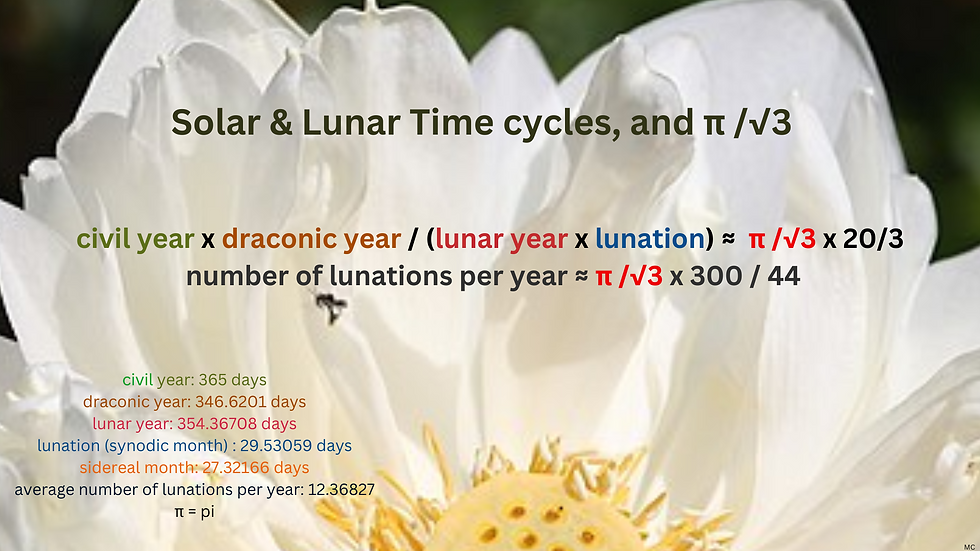
Using π /√3 and the inch at Giza to interpret the dimensions challenges the idea of only looking for integer numbers of units when interpreting ancient sites starting from their dimensions.
It also challenges the idea of reading the dimensions in cubits only, even though it is the ratios between dimensions that matters here, which renders the unit secondary. However, reading the dimensions in inches allows us to connect the dimensions to key time cycles, with a surprising level of accuracy.
Another idea that can be challenged is that the architects of the Giza complex didn't understand irrational numbers as we do today, and would have been unable to use them in their designs. To this point, it might be best to respond with the idea of analysing the data first, and then making judgements on the architects' capabilities second.
Lastly, the notion that the architects could not have known these time cycles to such a degree of accuracy can also be challenged. Again, it is best to analyse the data first, before coming to conclusions about the architects' capabilities.
One thing is for sure, knowledge of the exact value of an irrational such as pi or the square root of three is beyond the scope of the human mind. As such, the use of irrational numbers within the design pertains to the divine realm. Looking at the measures in inches at Giza seems to reveal a pattern, the repeated use of 20 π / (3 x √3), which is often multiplied by 29.53059. Using calculator π and √3 works better, when trying to find the ratios between the various linear dimensions, than approximations such as 22/7, or 1.7235. Because knowledge of irrational numbers was considered a sacred or private matter to the Pythagoreans, hence the murder of Hippasus, it would also have been so to the ancient Egyptians. So perhaps we are unlikely to find any explanation of how they knew about, or why they were interested in, irrationals. Because there was a tendency to mix religion in with all aspects of life, the use of irrational numbers when computing divine time cycles linked to the gods that were the sun and the moon would probably have seemed appropriate.
Do the pyramids display temporal and spatial hierophany through geometry, or geometric hierophany through time and space? Perhaps we can imagine the pyramids of Giza as monuments to the sun and the moon, and the cycles of time drawn out by the heavenly bodies. We can also see them as monuments to creation, to phenomenon, and to consciousness, through the geometry of the circle and the triangle. This idea is derived from a study of the dimensions of Giza in inches, which reveals the presence of cyclic temporal patterns expressed in days. These cycles are integrated into a single system, to a fairly high degree of accuracy, held together by various irrationals, in particular, pi and the square root of three. And if we look to the written traditions that have come down to us from ancient Egypt and India, we can relate these irrationals to geometric expressions of certain concepts, such as creation, and consciousness. Through the geometry of the pyramids, and ancient Hindu texts, we can imagine a philosophical or theological framework within which the sun and moon are themselves conscious beings, and the ratio between pi and the square root of three represents a dynamic principle within consciousness. Irrational numbers cannot be expressed exactly, which places them, tantalisingly just beyond the reach of human comprehension, so that they may come to symbolise all that we cannot know.
Notes
The Serpent Power Being the Shat-Chakra-Nirupana and Padura-Panchaka, Two works on Laya Yoga, translated from the Sanskrit, with introduction and commentary by Arthur Avalon (Sir John Woodroffe), Ganesh & Co (Madras) Ltd, 1950, p 36.
"14. Then he, Dhananjaya, filled with amazement, with his hair standing on end; bowed down with his head, and, with joined palms, thus addressed the God. Arjuna said : 15. I see all the Gods, 0 God, in thy body, as also hosts of various classes of beings : Brahma, the Lord, seated on the lotus-seat, and all Rishis and heavenly serpents. 16. I see Thee of boundless form on every side with multitudinous arms, stomachs, mouths and eyes ; neither Thy end nor .the middle nor the beginning do I see, 0 Lord of the Universe, 0 Universal Form. 17. I see Thee with diadem, club, and discus; a mass of splendour shining everywhere, very hard to look at, all around blazing like burning fire and sun, and immeasurable. 18 . Thou art the Imperishable, the Supreme Being worthy to be known. Thou art the great Abode of this ·Universe; Thou art the undying Guardian of the Eternal Dharma, Thou art the ancient Purusha, I deem. I9. I see Thee without beginning, middle or end, infinite in power, of manifold arms ; the sun and the moon being Thy eyes, the burning fire Thy face ; heating the whole Universe with Thy radiance." Bhagavad-Gita.with.the.Commentary.of.Sri.Shankaracharya.pdf (archive.org)
Michell, John, 1973, City of revelation : on the proportion and symbolic numbers of the cosmic temple, London: Abacus, City of revelation : on the proportion and symbolic numbers of the cosmic temple : Michell, John F : Free Download, Borrow, and Streaming : Internet Archive





Comments